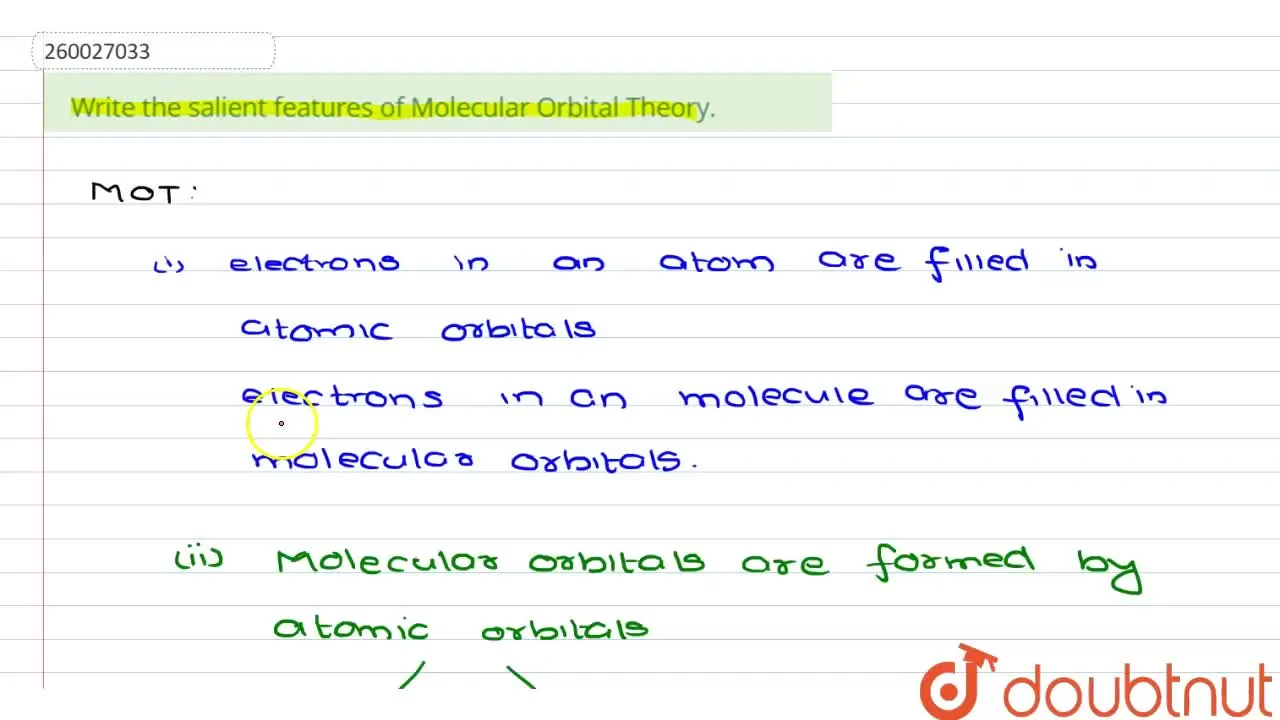Write the salient features of Molecular Orbital Theory. Solution in Telugu
M.O.T. was proposed by Hund and Mulliken.
1) Formation of MOs : The atomic orbitals of the bonded atoms with similar energies and symmetrical with respect to the inter-nuclear axis lose their identities, merge together and give rise to a set of new orbitals, named, 'molecular orbitals'.
2) Now in the molecule, the electrons will be influenced by the nuclei of all atoms, since the m.o. covers all the nuclei.
3) The m.o.'s are formed by LCAO method.
4) The number of m.o.'s produced is equal to the number of a.o's that combine.
5) Half of these m.o.'s possess lower energy than the a.o's from which they form. They are called, bonding m.o's. The remaining half wil have higher energy. They are called, anti bonding m.o's
6) The shape of m.o's is determined by the shapes of a.o's from which they form.
7) Axial overlap of two a.o's gives σ m.o's while parallel overlap gives π m.o's.
8) Based on spectroscopic studies, the relative order of energy of the m.o's of ten m.o's of Li2,Be2,B2,C2 and N2 are :
σ1s<σ∗1s<σ2s<σ∗2s<π2py=π2pz<σ2px<π⋆2py=π⋆2pz<σ⋆2px
But in case of O2,F2,Ne2 molecules, the relative order 1s
σ1s<σ⋆1s<σ2s<σ⋆2s<σ2px<π2py=π2pz<π⋆2py=σ⋆2pz<σ⋆2px
(position of σ2px m.o's changes)
9) Electrons occupy the m.o's which reflects Aufbau principle, Hund's rule of maximum multiplicity and Pauli's exclusion principle.
10) Electrons present in bonding m.o's help to stablise the bond, while those present in anti bonding m.o's more than destabilize the bond.
11) The inner orbitals which do not take part in bonding are called, 'non-bonding orbitals'.
Related Playlists
- BOOK - VGS PUBLICATION-BRILLIANTCHAPTER - CHEMICAL BONDING AND MOLECULAR STRUCTUREEXERCISE - SHORT ANSWER QUESTIONS33videos
CHEMICAL BONDING AND MOLECULAR STRUCTURE
- BOOK - VGS PUBLICATION-BRILLIANTCHAPTER - ATOMIC STRUCTUREEXERCISE - ADDITIONAL QUESTIONS & ANSWERS22videos
ATOMIC STRUCTURE
- BOOK - VGS PUBLICATION-BRILLIANTCHAPTER - CHEMICAL EQUILIBRIUM AND ACIDS-BASESEXERCISE - ADDITIONAL QUESTIONS & ANSWERS8videos
CHEMICAL EQUILIBRIUM AND ACIDS-BASES
Similar Questions
Write the general properties of Ionic Compounds.
06:14View SolutionCalculate the number of protons , neutrons and electrons in .8035Br
View SolutionPCl5,PCl3 and Cl2 are at equilibrium at 500K and having concentration 1.59MPCl3,1.59MCL2 and 1.41MPCl5. Calculate Kc for the reaction PCl5⇔PCl3+Cl2
03:04View Solutionआणविक ऑर्बिटल सिद्धान्त के मुख्य लक्षणों का वर्णन कीजिए ।
05:16View Solutionwhat are the salient feature of Crystal Field Theory (CFT) ?
03:31View SolutionSalient features of Molecules Orbital Theory (MOT)
View SolutionWhat are the salient features of Valence Bond (VB) theory?
02:22View SolutionExplain about the salient features of molecular orbital theory.
02:43View SolutionExplain about the salient features of molecular orbital theory.
View SolutionEnumerate the salient features of mutation theory.
10:26View SolutionGive the salient features of " Modern atomic theory ".
06:54View SolutionGive features of Molecular orbital MO) theory.
04:19View SolutionMolecular Orbital Theory (MOT) is an advanced theory of chemical bonding .
Write the salient features of MOT.04:53View SolutionMolecular orbitals are formed by the linear combination of atomic orbitals (LCAO). Give the salient features of the molecular orbital theory.
04:13View SolutionMolecular orbitals are formed by the linear combination of atomic orbitals (LCAO). Give the salient features of the molecular orbital theory.
03:36View Solution


